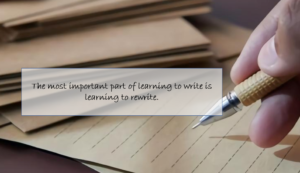11.03.22Make editing and revision of student writing visible, precise, and an ‘every day thing.’ (Video)

Teaching writing well is one of the most important things we can do in the classroom as teachers. The ability to capture and idea with precision and nuance is deeply connected to the ability to generate ideas of precision and nuance. And as Judith Hochman wisely points out in The Writing Revolution, there’s a big difference between assigning a lot of writing and teaching writing.
One of the keys to teaching writing well is ensuring that students get and use precise feedback frequently. I tried to write about this is Technique 42 of TLAC 3.0: Regular Revision– ‘the simple idea that we can make student writing better by making revision an everyday act, often done in short simple doses.” That is, we often give and ask students to apply feedback (only) as part of the essay writing process. Using and applying small pieces feedback in shorter pieces of student work daily would be much better.
This video of Fran Goodship and her students at London’s Solebay Academy is a great example of how to do Regular Revision well.
goodship.fran.ratio.mov (Original).mov from TLAC Blog on Vimeo.
As you can see she is projecting Jannatun’s work to the class and she’s asked them to suggest changes. Notice how specific and powerful the feedback is. When Sara suggests that Jannatun should add a conjunction to link ideas, they look at a specific example: the run-on sentence, “I like to play in the park, I like to play tag.” They talk about an exact solution. They see Jannatun apply it correctly.
It’s so simple but one of the keys to making feedback specific and useful is making writing visible via Show Call.
One of the principles of cognitive science that’s relevant here is the “transient information effect.” The idea is that if something is not visible to me, I have to hold my recollection of it in working memory. This gives me less of my very finite WM to apply to analysis or memory building. But so often when we talk about student writing are students are trying to remember it while they talk about it. Someone reads their work and then we discuss it. The result is vague discussion and poor memory of solutions. Here students can see every step of the process: what the mistake looks like; how Jannatun fixes it.
The first step in having a productive and useful shared discussion about writing is to for all of us to see the writing we are talking about, and ideally to see the whole time and especially it as it changes with revision.
Fran does a really beautiful job of that here. She gives Jannatun real ownership through the live editing. And of course Jannatun’s fellow students are doing the analytical work by providing the feedback.
We especially like the way she divides Sara’s feedback into two distinct parts and takes them on one at a time. And the way she solicits suggestions from Jannatun’s peers to eliminate repetition.
Notice also Jannatun’s reaction. She’s totally comfortable with the proceedings. Proud even. Of course she is. The process makes her writing seem very important and meaningful to be studied and discussed like that. It helps that Fran let’s her suggest some of her own improvements and gives her credit for that in front of the class, but she clearly feels the respect implicit in having her work become the focus of the class’ thinking. (Notice also that, as the video fades out, Fran is Show Calling another students’ work…)
